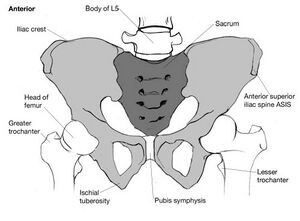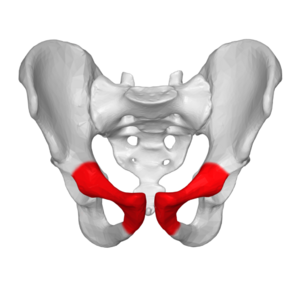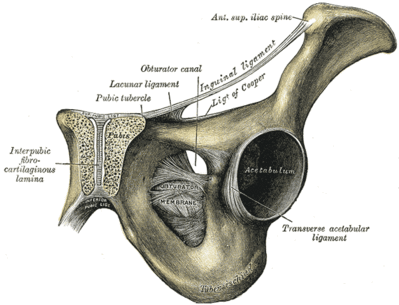Osteitis Pubis: Difference between revisions
No edit summary |
No edit summary |
||
| Line 3: | Line 3: | ||
== Introduction == | == Introduction == | ||
[[File:Pelvis ant.jpeg|right|frameless]] | [[File:Pelvis ant.jpeg|right|frameless]] | ||
Osteitis [[pubis]] is defined as | Osteitis [[pubis]] is defined as non-infectious idiopathic, [[Inflammation Acute and Chronic|inflammatory]] condition of the pubic symphysis and surrounding structures, but it is most likely related to overuse or trauma<ref>Up to date [https://www.uptodate.com/contents/osteitis-pubis#! Osteitis Pubis] Available:https://www.uptodate.com/contents/osteitis-pubis#! (accessed 8.11.2021)</ref>. Osteitis pubis was first described in patients who had undergone suprapubic [[Surgery and General Anaesthetic|surgery]], and it remains a well-known complication of invasive procedures about the [[pelvis]]. It may also occur as an inflammatory process in athletes<ref>Gomella P, Mufarrij P. [https://www.ncbi.nlm.nih.gov/pmc/articles/PMC5737342/ Osteitis pubis: a rare cause of suprapubic pain]. Reviews in urology. 2017;19(3):156. Available:https://www.ncbi.nlm.nih.gov/pmc/articles/PMC5737342/ (accessed 8.11.2021)</ref>. | ||
Image 1: anterior view of the pelvis. | Image 1: anterior view of the pelvis. | ||
| Line 16: | Line 16: | ||
== Clinical presentation == | == Clinical presentation == | ||
The most common symptom of Osteitis pubis is pain in the pelvis area. Pain is often central,but on one side it can be worse than on the other. It can also radiate down to one leg or groin. The most common complaints include:<ref name=":0">Benoy Mathew. Physiotutors. 2023 [cited 2023 Aug 21]. GETTING TO GRIPS WITH PUBIC-RELATED GROIN PAIN – OSTEITIS PUBIS IN RUNNERS. Available from: <nowiki>https://www.physiotutors.com/osteitis-pubis/</nowiki></ref> | |||
* Pain localized over the symphysis and radiating outward | |||
* Adductor pain or lower abdominal pain that then localizes to the pubic area | |||
* Pain is worsened by activities such as running, pivoting on 1 leg, kicking, or pushing off to change direction, as well as by lying on the side | |||
* Pain occurring with walking, climbing stairs, coughing, or sneezing | |||
* A feeling of clicking or popping when you rise from a seated position or when you turn into a bed. | |||
* Point tenderness on palpation directly above the symphysis pubis. | |||
The presentation is typical with varying degrees of pelvic and/or perineal pain, reproduced on hip adduction.<ref name=":4" /> | The presentation is typical with varying degrees of pelvic and/or perineal pain, reproduced on hip adduction.<ref name=":4" /> | ||
| Line 40: | Line 49: | ||
Both radiographs and MRI aid in the diagnosis of osteitis pubis. In the early stage, plain radiographs might appear normal. | Both radiographs and MRI aid in the diagnosis of osteitis pubis. In the early stage, plain radiographs might appear normal. | ||
* In chronic osteitis pubis, the pubic symphysis demonstrates lytic changes, sclerosis, and widening. | * In chronic osteitis pubis, the pubic symphysis demonstrates lytic changes, sclerosis, sub-chondral resorption, bony margin irregularities and widening. | ||
* Dynamic instability of the pubic symphysis can be observed on the flamingo view (obtained by double- and single-legged stance positions bilaterally on a pelvic anterior-posterior radiograph). Greater than 2 mm of subluxation is considered a positive finding for symphyseal instability. | * Dynamic instability of the pubic symphysis can be observed on the flamingo view (obtained by double- and single-legged stance positions bilaterally on a pelvic anterior-posterior radiograph). Greater than 2 mm of subluxation is considered a positive finding for symphyseal instability. | ||
* X-rays of patients with osteitis pubis typically show an irregular pubic symphysis with sclerotic (thick) bone edges and evidence of chronic inflammation.<ref name=":0" /> | |||
* MRI has become the imaging modality of choice. MRI has a high sensitivity for distinguishing between chronic and acute cases.<ref name=":4" /> | * MRI has become the imaging modality of choice. MRI has a high sensitivity for distinguishing between chronic and acute cases.<ref name=":4" /> | ||
| Line 62: | Line 72: | ||
* [[Adductor Tendinopathy|Adductor strain]] | * [[Adductor Tendinopathy|Adductor strain]] | ||
* Rectus Abdominus strain | * Rectus Abdominus strain | ||
* Sacroiliac joint dysfunction | |||
* Femoro-acetabular impingement (FAI)<ref name=":0" /> | |||
* Genitourinary disease | |||
== Viewing == | == Viewing == | ||
Revision as of 22:02, 21 August 2023
Introduction[edit | edit source]
Osteitis pubis is defined as non-infectious idiopathic, inflammatory condition of the pubic symphysis and surrounding structures, but it is most likely related to overuse or trauma[1]. Osteitis pubis was first described in patients who had undergone suprapubic surgery, and it remains a well-known complication of invasive procedures about the pelvis. It may also occur as an inflammatory process in athletes[2].
Image 1: anterior view of the pelvis.
Quick Facts[edit | edit source]
- Osteitis pubis is a rare cause of groin pain but is more common in athletic patients, specifically soccer players, runners, and rugby players.
- Patients often present with groin pain made worse with activity.
- Plain radiographs and MRIs may aid with the diagnosis.
- The condition is usually treated with NSAIDs, activity restriction, and physical therapy.
- In rare cases, surgical intervention may be required[3].
Clinical presentation[edit | edit source]
The most common symptom of Osteitis pubis is pain in the pelvis area. Pain is often central,but on one side it can be worse than on the other. It can also radiate down to one leg or groin. The most common complaints include:[4]
- Pain localized over the symphysis and radiating outward
- Adductor pain or lower abdominal pain that then localizes to the pubic area
- Pain is worsened by activities such as running, pivoting on 1 leg, kicking, or pushing off to change direction, as well as by lying on the side
- Pain occurring with walking, climbing stairs, coughing, or sneezing
- A feeling of clicking or popping when you rise from a seated position or when you turn into a bed.
- Point tenderness on palpation directly above the symphysis pubis.
The presentation is typical with varying degrees of pelvic and/or perineal pain, reproduced on hip adduction.[5]
Epidemiology[edit | edit source]
To date, there has been no epidemiological study to determine the true incidence of osteitis pubis. The incidence in athletes has been reported as 0.5% to 8%, with a higher incidence in distance runners and athletes in kicking sports, in particular, male soccer players who account for 10% to 18% of injuries per year.[3]
Etiology[edit | edit source]
Image 2: Anterior view pelvis, pubis bone red.
Although the aetiology is sometimes unknown, the most common causes are:
- Pregnancy/childbirth
- High-level of athletic activity: see athletic pubalgia
- Urological or gynaecological surgery
- Trauma
- psoriatic arthritis
- ankylosing spondylitis[5]
Pathophysiology[edit | edit source]
The pubic symphysis is a non-synovial amphiarthrodial joint with an interposed fibrocartilaginous disc separating hyaline cartilage. The joint normally has minimal motion due to the static ligamentous complex. The pubic symphysis serves as the insertion point of the rectus abdominis and origin of the adductor complex. The antagonistic nature of the rectus abdominis, which elevates the pubic symphysis while the adductors depress the joint, serves as a nidus for the development of osteitis pubis—the repetitive use of the anterior pelvic musculature results in chronic tendinosis. The chronic muscle imbalance results in abnormal forces across the pubic symphysis, causing symphyseal instability, pubic bone stress reaction, and eventually degeneration of the hyaline cartilage. Another emerging theory poses that osteitis pubis develops secondary to increased compensatory motion across the joint because of limited motion elsewhere in the kinetic chain, such as in femoroacetabular impingement.[3]
Diagnosis[edit | edit source]
Both radiographs and MRI aid in the diagnosis of osteitis pubis. In the early stage, plain radiographs might appear normal.
- In chronic osteitis pubis, the pubic symphysis demonstrates lytic changes, sclerosis, sub-chondral resorption, bony margin irregularities and widening.
- Dynamic instability of the pubic symphysis can be observed on the flamingo view (obtained by double- and single-legged stance positions bilaterally on a pelvic anterior-posterior radiograph). Greater than 2 mm of subluxation is considered a positive finding for symphyseal instability.
- X-rays of patients with osteitis pubis typically show an irregular pubic symphysis with sclerotic (thick) bone edges and evidence of chronic inflammation.[4]
- MRI has become the imaging modality of choice. MRI has a high sensitivity for distinguishing between chronic and acute cases.[5]
Treatment[edit | edit source]
The management of osteitis pubis includes both conservative and surgical options.
The first option remains conservative treatment.
- Conservative management includes: rest, NSAIDs; progressive course of physical therapy (see pubalgia). There is no standard conservative treatment protocol resulting in a variety of outcomes. The conservative treatment of osteitis pubis can be protracted. It may take some athletes six months or more to return to the preinjury level, but more commonly, most return by 3 months.
- Albeit protracted, conservative management remains the mainstay of treatment. Only approximately 5% to 10% of athletes require surgical treatment.
Steroid injections have been demonstrated as a useful adjunctive therapy
If conservative management does fail, surgical intervention may be required. The timeframe of when to consider conservative treatment as a failure ranges and no set timetable has been established. Commonly, a minimum of six months of conservative treatment is attempted before surgical options are discussed[3].
Differential Diagnosis[edit | edit source]
- Athletic pubalgia
- Osteomyelitis
- Adductor strain
- Rectus Abdominus strain
- Sacroiliac joint dysfunction
- Femoro-acetabular impingement (FAI)[4]
- Genitourinary disease
Viewing[edit | edit source]
The short video below is of Physiotherapy techniques used for osteitis pubis
References[edit | edit source]
- ↑ Up to date Osteitis Pubis Available:https://www.uptodate.com/contents/osteitis-pubis#! (accessed 8.11.2021)
- ↑ Gomella P, Mufarrij P. Osteitis pubis: a rare cause of suprapubic pain. Reviews in urology. 2017;19(3):156. Available:https://www.ncbi.nlm.nih.gov/pmc/articles/PMC5737342/ (accessed 8.11.2021)
- ↑ 3.0 3.1 3.2 3.3 Dirkx M, Vitale C. Osteitis Pubis. StatPearls [Internet]. 2021 Jan 1.Available:https://www.ncbi.nlm.nih.gov/books/NBK556168/ (accessed 8.11.2021)
- ↑ 4.0 4.1 4.2 Benoy Mathew. Physiotutors. 2023 [cited 2023 Aug 21]. GETTING TO GRIPS WITH PUBIC-RELATED GROIN PAIN – OSTEITIS PUBIS IN RUNNERS. Available from: https://www.physiotutors.com/osteitis-pubis/
- ↑ 5.0 5.1 5.2 Radiopedia Osteitis Pubis Available: https://radiopaedia.org/articles/osteitis-pubis(accessed 8.11.2021)
- ↑ Pelvic pain Rehab Video-Osteitis Pubis. Available from: https://www.youtube.com/watch?v=7U5GLjR92Dk
.









